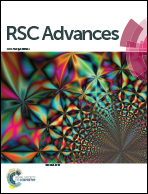Enhancing antimicrobial properties of poly(vinylidene fluoride)/hexafluoropropylene copolymer membrane by electron beam induced grafting of N-vinyl-2-pyrrolidone and iodine immobilization†
Abstract
Highly efficient antimicrobial properties were imparted to a solution cast poly(vinylidene fluoride)-co-hexafluoropolypropylene (PVDF-co-HFP) NF membrane by modification with povidone–iodine (PVP–I2) complex using electron beam (EB) induced grafting of N-vinyl-2-pyrrolidone (NVP) and subsequent iodine immobilisation. The changes in the morphology of the PVDF-co-HFP membrane in correlation with preparation procedure (NVP grafting and I2 loading) were monitored by a field emission scanning electron microscope (FESEM) whereas, the variation in chemical composition was investigated with FTIR-ATR, UV-vis/NIR and energy dispersive X-ray (EDX). The free surface energy and hydrophilicity/hydrophobicity of the membranes were studied using contact angle measurements. The antimicrobial activity of I2 loaded membrane was evaluated against Gram negative Escherichia coli and Gram positive Staphylococcus aureus in comparison with pristine and PVP grafted membranes. The pure water permeation flux and bacterial suspension filtration through the membranes were also investigated. The use of radiation grafting with EB was found to be highly effective in modification of PVDF-co-HFP membrane by imparting PVP ligands capable of hosting I2 and conferring it very strong antimicrobial activity. Moreover, the obtained membrane is highly promising for water disinfection applications.


 Please wait while we load your content...
Please wait while we load your content...